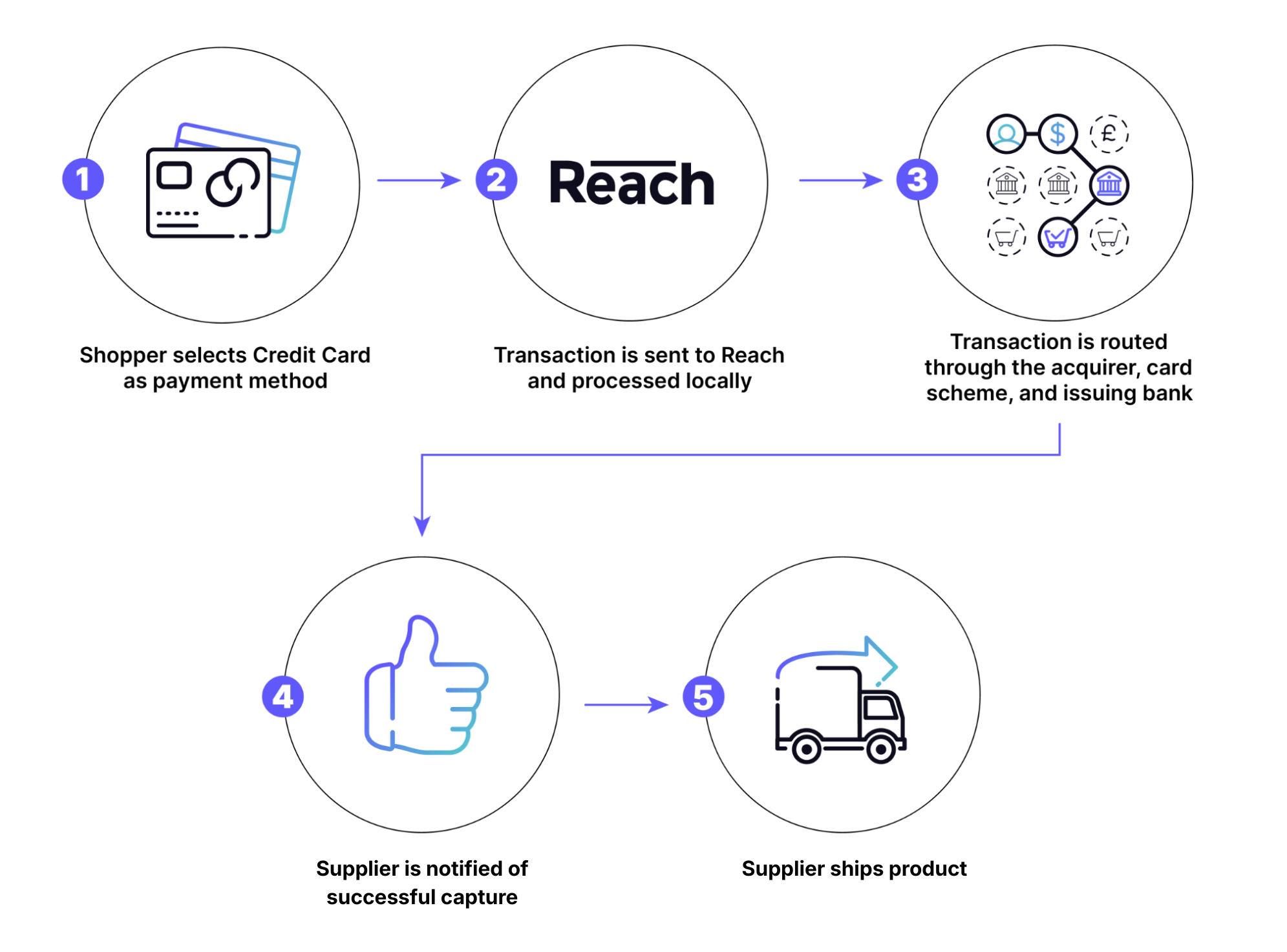Credit cards
Credit cards are a form of card payment where the card issuer extends a line of credit to the cardholder, allowing the cardholder to purchase goods or services. The main variations are:
A credit card allows you to borrow money from a bank to buy items now and pay for them later, up to a specified limit.
Payment Flow

- The consumer selects a card on the payment page.
- The supplier sends the request to Reach.
- Reach directs the authorization request to the relevant acquiring channel.
- The acquirer directs the authorization request to the card-issuing bank.
- The card-issuing bank processes the transaction in real-time, returning an authorization or decline response.
- The acquirer sends the authorization result to Reach.
- Reach returns the request response result to the supplier.
- You can release the product or service to the consumer if the request is authorized.
Examples and implementation
Properties
Type of Payment
Card
Chargebacks
Yes
Consumer Currency
Any (except for restricted countries)
Consumer Country
Any (except for restricted countries)
Expiry Period
We recommend 7 days, but you can extend it in special circumstances.
Recurring Payments
Yes
Partial Payment
Yes, depending on the setup. Partial capture (capture less than the authorized amount) is possible.
Refunds
Yes. We may reject refund requests if the refund's value exceeds 100% of the value of the collected transactions.
Important considerations
- Debit cards physically look like credit cards. Funds are withdrawn directly from the cardholder's bank account (often called a check card). However, for suppliers, many debit cards are processed the same way as credit cards.
- Debit cards are often co-branded, enabling consumers to use them globally. There are many other types of debit cards, each accepted regionally or nationally. For example, the following are national debit brands: Maestro, Visa Electron, and Carte Bleue.
- A card authorization confirms that a customer has sufficient funds to purchase the goods or services they request and that their card issuer agrees to honor the payment.
- When a consumer completes a transaction, the authorization is applied to the customer's credit limit.
- When an authorization hold expires, you can no longer use it to capture funds (settlement), and the supplier must reauthorize the transaction before delivery.
- You can make a capture request if the authorization hold is still valid.
- When you issue a capture request, the authorization hold changes into a settlement request, and charges the amount from the settlement request to the cardholder's account.
Best practices
- We require the billing address and card verification value (AVS and CVV)
- Address Verification Service (AVS) verifies the credit card billing address of the customer paying with a credit card. You need to include an AVS request with the transaction authorization, and you will receive a result code (separate from the authorization response code) that indicates whether the address given by the cardholder matches the address in the issuer‘s file. A partial or no-match response may indicate increased fraud risk. AVS services are currently available in the UK and the US.
- Card Verification Value 2 (CVV2) is a three- or four-digit code printed on the signature panel of all credit cards.
- MOTO and Internet suppliers use CVV2 to verify that the customer has a legitimate credit card at the time of the order.
- You can request the customer for the CVV2 code and send it to the issuer as part of the authorization request.
- If possible, take advantage of Reach's PCI offloading capabilities. We are PCI-DSS Level 1 Compliant. Offloading your PCI burden to Reach can be a great way to avoid your own costly and time-consuming PCI compliance.
- If possible, avoid storing any cards or personal data.
- It's usually a bad idea to ship before capture is complete.
Technical considerations
The ability to handle notifications is key to successful credit card processing
Credit cards are a popular payment method worldwide, but your technical integration must reflect local buying habits.
Supported cards include:
- Visa | VISA | All markets
- Diners | DINERS | All markets
- American Express | AMEX | All markets
- Japan Card | JCB | All markets
- Mastercard | MC | All markets
- Discover | DISC | All markets
- Maestro | MAESTRO | All markets
- Visa Electron | ELECTRON | All markets
- Debit Card | DEBIT | MX
- Elo | ELO | BR
- Hipercard | HIPERCARD | BR
- Aura | AURA | BR
- China Union Pay | UNIONPAY | CN, HK, MO, SG, JP, KR
- Dankort | DANKORT | DK
- CMR Falabella | CMR | AR
- Cordobesa | CORDOBESA | AR
- Nativa | NATIVA | AR
- Tarjeta Shopping | TARJETA | AR
- Cencosud | CENCOSUD | AR
- Cabal | CABAL | AR
- Cordial | CORDIAL | AR
- Argencard | ARGEN | AR
- Naranja | NARANJA | AR
- OCA | OCA | UY
- Lider | LIDER | UY
- RuPay | RUPAY | IN
Testing
Testing card numbers and information is available from our support team at [email protected].
You can find our test tool at https://checkout.rch.how/.
Related information
See our Checkout API guide for more details.
Updated 7 days ago
